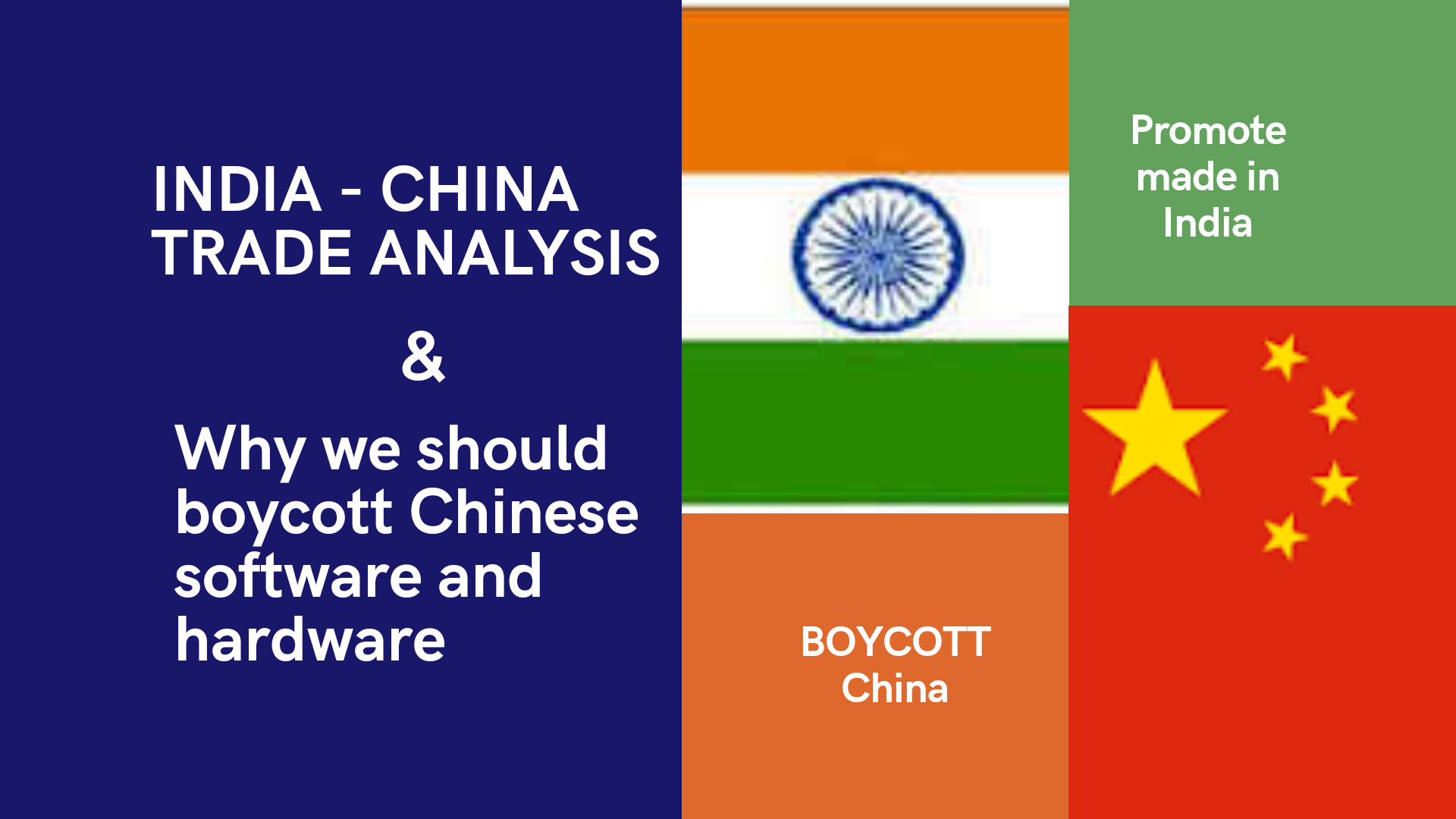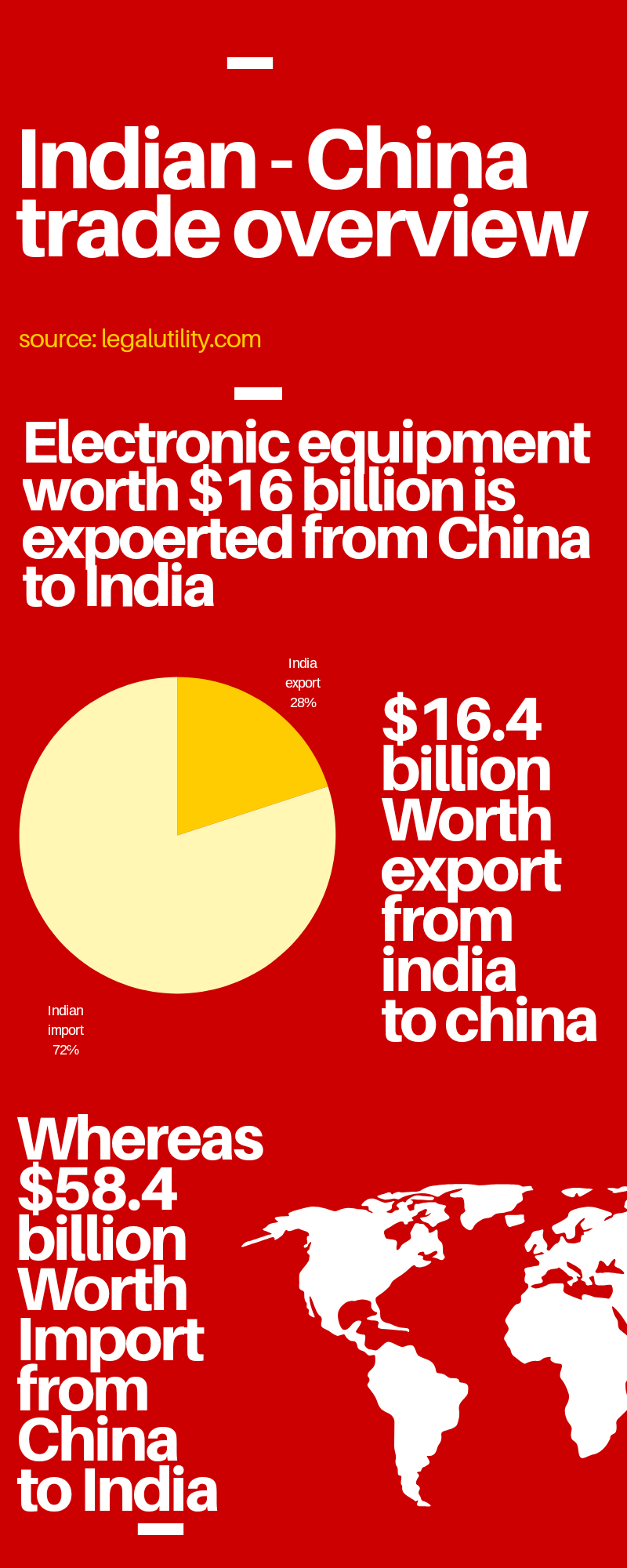
Content
- Introduction
- Bilateral Trade
- The 10 major products exported from India to China were
- The 10 major products exported from China to India were
- Reasons to avoid using Chinese Hardware and Software
- Conclusion
INTRODUCTION
A China–India relation, additionally called Sino-Indo relations or Indian-Chinese relations, alludes to the bilateral connection among China and India. In spite of the fact that the relationship has been sincere, there have been outskirt debates.
The advanced relationship started in 1950 when India was among the primary nations to end formal binds with the Republic of China (Taiwan) and perceive the People’s Republic of China as the genuine legislature of Mainland China.
China and India are the two most crowded nations and quickest developing significant economies in the world. Development in strategic and monetary impact has expanded the hugeness of their reciprocal relationship.
Social and monetary relations among China and India go back to antiquated occasions. The Silk Road not just filled in as a significant exchange course among India and China, but on the other hand is credited for encouraging the spread of Buddhism from India to East Asia.
During the nineteenth century, China’s developing opium exchange with the British East India Company set off the First and Second Opium Wars. During World War II, British- involved India and China both assumed a vital job in stopping the advancement of Imperial Japan.
Relations between contemporary China and India have been portrayed by fringe questions, bringing about three military clashes – the Sino-Indian War of 1962, the Chola occurrence in 1967, and the 1987 Sino-Indian engagement.
In mid-2017, the two nations conflicted at the Doklam level along the contested Sino-Bhutanese outskirt. Nonetheless, since the late 1980s, the two nations have effectively reconstructed conciliatory and financial ties.
In 2008, China turned into India’s biggest exchanging accomplice and the two nations have likewise broadened their key and military relations.
Aside from exchange and trade, there are some different territories of shared enthusiasm on which China and India have been coordinating recently. In the expressions of Rejaul Karim Laskar, a researcher of Indian international strategy, “Right now, the two nations are collaborating on a scope of worldwide like exchange, environmental change and change of the worldwide money related request, among others, to advance regular premium”.
In spite of developing monetary and vital ties, there are a few obstacles for India and the PRC to survive. India faces exchange unevenness intensely for China. The two nations neglected to determine their fringe contest and Indian news sources have over and over revealed Chinese military invasions into Indian Territory.
Both nations have consistently settled military framework along outskirt areas. Additionally, India stays vigilant about China’s solid vital two-sided relations with Pakistan, while China has communicated worries about Indian military and financial exercises in the contested South ChinaSea.
In June 2012, China expressed its position that “Sino-Indian ties” could be the most “significant two-sided organization of the century”. That month Wen Jiabao, the Premier of
China and Man Mohan Singh, the Prime Minister of India set an objective to increment reciprocal exchange between the two nations to US$100 billion by 2015.
Reciprocal exchange among China and India contacted US$89.6 billion out of 2017–18, with the exchange deficiency enlarging to US$62.9 billion in China’s favor. In 2017, the volume of two-sided exchange between India and China remains at US$84.5 billion. This figure avoids respective exchange between India and Hong Kong which remains at another US$34 billion.
As indicated by a 2014 BBC World Service Poll, 23% of Indians see China emphatically, with 47% communicating a contrary view, while 27% of Chinese individuals see India decidedly, with 35% communicating a negative view.
A 2014 overview led by the Pew Research Center indicated 72% of Indians were worried that regional debates among China and neighbouring nations could prompt a military clash.
The CCP General Secretary and President of China, Xi Jinping, was one of the top world pioneers to visit New Delhi after Narendra Modi took over as Prime Minister of India in 2014.
India’s request to bring South China Sea up in different multilateral discussions in this manner didn’t help that start indeed, the relationship confronting doubt from Indian organization and media the same.
In 2020, the 70th commemoration of India-China political ties, 70 occasions will be held in festivity by the two nations. Different exercises are likewise arranged.
BILATERAL TRADE
Chinese imports from India amounted to $16.4 billion or 0.8% of its overall imports, and 4.2% of India’s overall exports.

The 10 major products exported from India to China were:
- Cotton: $3.2billion
- Gems, precious metals, coins: $2.5billion
- Copper: $2.3billion
- Ores, slag, ash: $1.3billion
- Organic chemicals: $1.1billion
- Salt, sulphur, stone, cement: $958.7million
- Machines, engines, pumps:$639.7lmillion
- Plastics: $499.7million
- Electronic equipment: $440million
- Raw hides excluding foreskins: $432.7million
Chinese exports to India amounted to $58.4 billion or 2.3% of its overall exports, and 12.6% of India’s overall imports.
The 10 major products exported from China to India were:
- Electronic equipment: $16billion
- Machines, engines, pumps: $9.8billion
- Organic chemicals: $6.3billion Fertilizers: $2.7billion
- Iron and steel: $2.3billion
- Plastics: $1.7 billion
- Iron or steel products: $1.4billion
- Gems, precious metals, coins: $1.3billion
- Ships, boats: $1.3billion
- Medical, technical equipment: $1.2billion
An analysis of India-china trade relation shows that the magnitude of trade has expanded rapidly over the past few years. China is emerging as a significant link in the manufacturing chai of the world. While India’s potential for knowledge based services and manufacturing is being Noticnotic
Reasons to avoid using Chinese Hardware and Software
Consumers in India have been using Chinese products over the years. Indians are heavily dependent on these Chinese products. There are number of goods which is imported from China to India, whether it is smartphones or goods for daily use.
Products which are made by Indian companies are dependent on inputs and raw materials which are imported from China to India, such as two-third of drugs used in making medicines are imported from China.
Chinese goods are low in quality, then why do consumer choose to purchase it? Answer to this question is “PRICE OF THE PRODUCT”.
The products that are sold by china are 10-70 per cent cheaper than Indian products, although durability and quality has always been an issue with these
goods.
With the increasing number of users of smartphones and the internet, India has become the world’s fastest-mobile app market in the past few years.
China has also captured Indian digital sector consisting of applications available on google play store- Entertainment and short film applications such as TikTok, Data sharing applications such as SHAREit, Web Browsers such as UCBrowser, LPGaming apps such as PUBG, Clash of Kings, Ecommerce applications such as Shein, Club Factory are some of the popular Chinese softwares used by Indians.
Chinese firms have occupied a wide space in hardwares. Smartphones made by china (Xiaomi, Realme, Vivo) has obtained 73% of the sale in India, whereas smartphones made by Indian (Samsung and Nokia) has accounted only 23% of the sale. Consumers search for products which are sold at cheaper price and are attracted towards Chinese products due to “value for money”.
l Boycott Chinese Products Indian Government has taken several steps to cope up with the economy and the infrastructure which has been disturbed due to COVID-19 pandemic. ‘Aatmanirbhar Bharat Abhiyaan’ scheme was launched on 12 May 2020.
Its main goal is to become self-reliant and ‘Make in India’ movement, which means the people of India must increase the use of products which are made by Indian companies. Use of Chinese products should be boycotted, and the Indian companies mustsale steal their sale.
Since the past few weeks, Campaign named as “Boycott Made in China or Stop using and buying Chinese products” has been going through all over the internet and social media platforms.
The reason behind this campaign is territorial conflict including china, cheap quality products sold by china, Prime ministers appeal for economic self-reliance ‘Aatmanirbhar Bharat’ and China being a country which is declared guilty of manufacturing and spreading the novel coronavirus.
An Indian engineer, educator and innovator named Sonam Wangchuk has appealed to people of India to make use of Indian products and boycott Chinese products. He also mentioned “Stop using Chinese Software in one week and Hardware in a year”.
This made a heavy impact on Indians as a lot of people downloaded ‘Remove China Apps’ to uninstall Chinese applications and software from their smartphones, laptops and other devices.
The Social media platform is also flooded with ‘Boycott of Chinese products including software and hardware’ and trends as #BoycottChina.
Celebs and sports fraternity who are the brand ambassador of Chinese products are also requested to stop endorsements and promotion of these products.
After the clash on the Galwan borders with china, 20 soldiers fell to death by the Chinese troops. The CAIT (Confederation of All India Traders) decided to take an aggressive step against China by boycotting Chinese goods.
The new campaign named ‘Bhartiya Samaan Hamara Abhimaan’ was launched after this decision. It released a broad list of 450 categories of commodities to boycott china and promote the use of Indian goods.
Boycotting Chinese software and hardware will increase the sale of Indian products like Indian smartphone- Samsung and Nokia which used to lead the market. It will help India in becoming ‘Aatmanirbhar’.
It will promote small-scale industries, start-ups, manufacturing of new products which can replace Chinese goods and will increase employment opportunities in India, also reduce the dependence of India on Chinese goods.
CONCLUSION
India is depended on applications with Chinese investments, these apps are widely used and downloaded by both IOS and Google Play Store. It includes web browsers, data sharing, social media apps, entertainment and short film apps etc. This shows the dominance of China over India’s digital market.
‘Made in China’ label has been rolling all over the consumer products in India whether it is smartphones or toys children play with. India and China trade relation has been over many years and the Indian market is heavily dependent on China.
Even the shares invested in Indian companies are majorly Chinese investments. Major companies like Zomato, Ola Cabs etc. have their investment by Chinese investment firms like Alibaba group investors.
It is not an easy movement for India to boycott Chinese products. As China holds a very less percent of export from India as compared to its total percentage of export, boycotting Chinese product won’t hurt china’s economy.
But talking about India as its major import is from China, it is difficult for India to find substitutes for Chinese consumer goods.
China used low-quality input and cheap labour, which cost less in raw materials. It saves the tremendous cost of production and having many suppliers, distributors, customers give a large amount of revenue.


- RSPCB Recruitment 2023 | Law Officer | Last Date 17th November | Apply Now !

- NFL Recruitment 2023 | Management Trainee (LAW) | Apply Now !

- PGCIL Recruitment 2023 | Officer Trainee | LAW | Apply Now

- HPD Assam Recruitment 2023 | 302 Public Prosecutor | Last Date 30th November | Apply Now

- Supremacy of the Constitution or Parliamentary Sovereignty

- National Education Policy 2020 Highlights – NEP Objectives

- Law Graduate Jobs | Naks & Partners (Advocates & Solicitors) | Associate Legal (Drafting & Research) |

- International Health Regulation By: Prof.(Dr.) Pallavi Gupta, HOD JEMTEC School of Law

- CALL FOR INTERNS: JULY MONTH

- [Online] Interactive Certificate Course on Competition Law & Practice by MyLawman [Register by 17 June]


Leave a Reply
You must be logged in to post a comment.